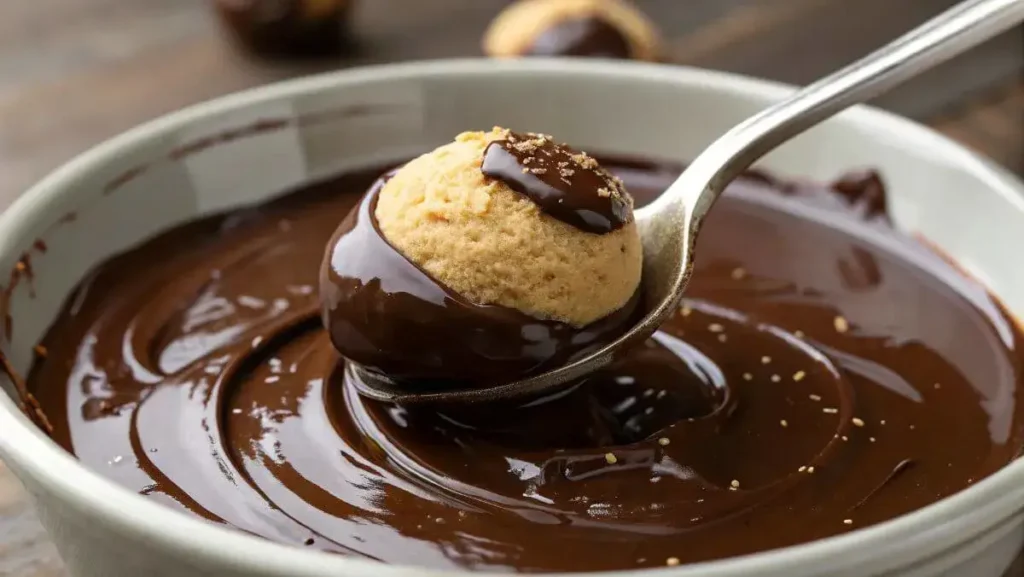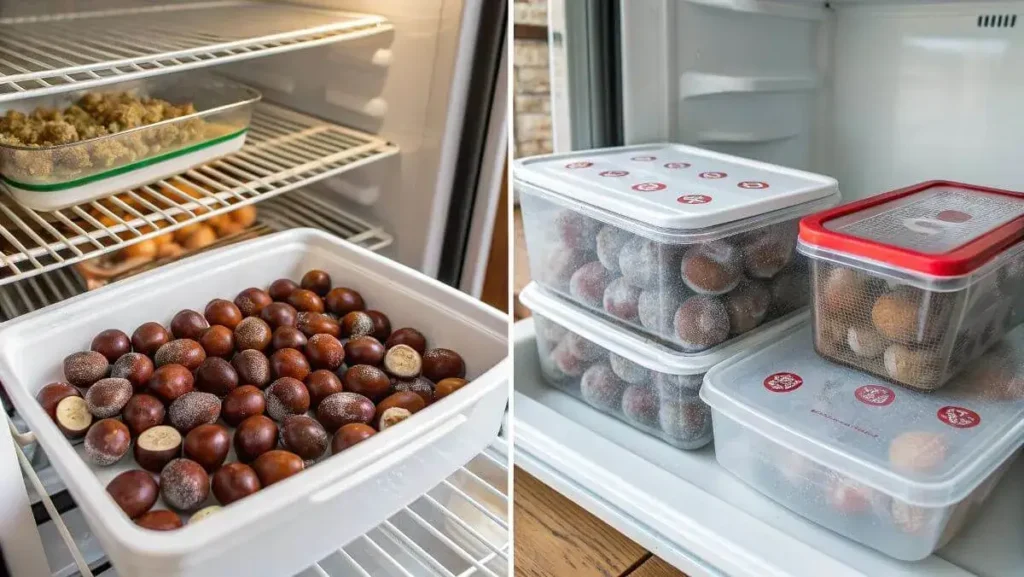Buckeyes are a cherished snack that features the tasty blend of chocolate and peanut butter in a tasty bite-sized treat. Despite their widespread appeal, a common question arises: do buckeyes require refrigeration? Knowing how to store buckeyes properly is crucial for keeping their flavor and freshness intact. This article will explore what buckeyes are, their key ingredients, how to store them properly, and whether refrigeration is necessary. By the end, you’ll have all the information needed to enjoy your buckeyes while keeping them delicious.
Introduction to Buckeyes
What Are Buckeyes?
Buckeyes are sweet treats made from a creamyBuckeyes consist of a creamy peanut butter filling covered in chocolate, resembling the nut of a buckeye tree. These treats are a beloved dessert that is particularly popular in the Midwestern United States, especially in Ohio, where they are celebrated as the state treat. Often made for holidays and special occasions, these treats are valued not just for their delightful flavor but also for their sentimental connections to family traditions.

Brief History and Cultural Significance
The origins of buckeyes are unclear, but their name is derived from the Aesculus glabra tree, commonly known as the buckeye tree. The brown nut-like seeds of the tree have a similar appearance to these delicious confections. Over the years, buckeyes have become a symbol of Ohio and have gained fame beyond the region as people share recipes and enjoy the treat at gatherings.
When asking the question, do buckeyes need to be refrigerated? It’s essential to consider their ingredients and how they affect storage. We’ll delve deeper into this topic in the upcoming sections, helping you keep your buckeyes fresh and enjoyable.
Nutritional Breakdown of Buckeyes
Key Ingredients in Buckeyes
When discussing whether buckeyes need to be refrigerated? It’s essential to look at their ingredients. Buckeyes typically consist of several key components:
- Peanut Butter: This creamy ingredient provides the rich, nutty flavor that defines babies. It is often mixed with powdered sugar to form a sweet, dense center.
- Chocolate: Semisweet chocolate chips or melting chocolate coat the peanut butter centers, giving them a delicious chocolatey shell.
- Powdered Sugar: This sweetener helps to create a smooth and sweet filling that perfectly complements the peanut butter.
- Butter: Many recipes call for a bit of butter to help soften the peanut butter and blend the ingredients smoothly.
Understanding these ingredients provides insight into their stability. Because of peanut butter and chocolate, the question of whether buckeyes need to be refrigerated becomes crucial, especially regarding their freshness and longevity.
Caloric and Nutritional Profile
Buckeyes are tasty but can be high in calories due to their ingredients. On average, one buckeye can hold around 100 calories or more, depending on the size and proportions used. If you’re looking at these treats through the health lens, remember that moderation is essential.
With that said, buckeyes do provide some nutritional benefits. Peanut butter is a good source of protein and healthy fats essential for energy. However, the high sugar means enjoying these treats on special occasions rather than as a daily snack.
Understanding the nutritional profile helps you gauge how to integrate buckeyes into your diet while considering whether buckeyes need refrigeration for optimal freshness and taste.
Understanding Food Safety
The Importance of Refrigeration for Homemade Treats
Food safety plays a significant role when asking if buckeyes must be refrigerated. Homemade buckeyes, specifically, may require refrigeration due to the ingredients used. Combining peanut butter and chocolate can create a rich environment for bacteria if not stored properly.
Generally, many homemade treats are best kept in the fridge to prolong their shelf life. Refrigeration can inhibit the growth of bacteria and mold, ensuring that your delicious treats remain safe. Moreover, chilling can help solidify the chocolate coating, making the buckeyes firmer and easier to handle.
How Ingredients Affect Buckeye Longevity
Now, let’s examine how specific ingredients in buckeyes affect their shelf life. Peanut butter has a relatively long shelf life when unopened, but it can become susceptible to spoilage once exposed to air and mixed with sugar. Chocolate may also spoil if left at room temperature for extended periods, especially in warm environments.
If you’re wondering how long buckeyes last unrefrigerated, they typically stay fresh for about 1 to 2 days when stored in an airtight container at room temperature. However, once you place them in the refrigerator, you can usually enjoy them for up to two weeks without losing flavor or texture.
In conclusion, when considering whether buckeyes need to be refrigerated? The answer is yes for homemade versions, particularly to maintain quality and safety. Always be mindful of how you store your treats to maximize freshness and enjoyment!
Do Buckeyes Need to Be Refrigerated?
Recommendations for Storing Buckeyes

Whether buckeyes need to be refrigerated is crucial when considering how to enjoy this delicious treat while maintaining its quality. It’s generally recommended to store homemade buckeyes in the refrigerator, especially if they contain perishable ingredients like nut butter and chocolate. Doing so can extend their freshness and prevent spoilage.
To properly store buckeyes, place them in an airtight container. This step is essential as it protects them from air exposure, which may lead to drying out or absorbing odors from the fridge. Keeping them at room temperature in a cool, dry place might be acceptable if you plan to consume them within a few days. However, for more extended storage, the fridge is the safer bet.
Signs That Buckeyes Have Spoiled
When keeping buckeyes on hand, knowing the signs of spoilage is just as important as how you store them. If you’re wondering if buckeyes need to be refrigerated, these signs will guide their condition:
- Mold Growth: If you notice any green or black spots, it’s time to toss them out.
- Unpleasant Odors: When buckeyes emit a sour or off smell, it’s a red flag.
- Texture Changes: If they become noticeably dry or complex, the texture is compromised, and they may not be enjoyable to eat anymore.
By recognizing these signs, you can ensure that you and your family enjoy buckeyes safely.
Tips for Storing Buckeyes Properly
Best Practices for Keeping Buckeyes Fresh
To maximize the freshness of your buckeyes, follow these simple tips:
- Allow to Cool Completely: Ensure your buckeyes are completely cooled before storing. This helps prevent condensation from forming inside the container, potentially leading to mold.
- Use Parchment Paper: If you plan on stacking your buckeyes in a container, place parchment paper between layers. This prevents them from sticking together, preserving their shape.
- Labeling: If you’re storing several batches or types of treats, label the container with the date they were made. This helps you keep track of their freshness.
How to Freeze Buckeyes for Longer Storage
If you’ve made a large batch of buckeyes and want to keep them longer, freezing is an excellent option. To freeze buckeyes properly, follow these steps:
- Wrap Individually: Wrap each buckeye in plastic wrap or aluminum foil to prevent freezer burn.
- Use a Freezer Bag: Place the wrapped buckeyes in a sealable freezer bag. This offers extra protection.
- Label and Date: Always label the bag with the date. Frozen buckeyes can last up to 3 months without losing quality so you can enjoy them later!
By employing these storage tips, you’ll ensure that your delicious buckeyes remain fresh, tasty, and ready to enjoy whenever you need a sweet treat. Do buckeyes need to be refrigerated? Helps you make the most of your culinary efforts!
FAQs: Do Buckeyes Need to Be Refrigerated?
How long do homemade buckeyes last at room temperature?
One common question regarding whether buckeyes need to be refrigerated. It is how long they can be kept at room temperature. Homemade buckeyes can last about 1 to 2 days when stored in a cool, dry place. However, keeping them in an airtight container is best to prevent them from drying out or absorbing unwanted odors.
Can you eat buckeyes after they’ve been on the counter for a while?
If buckeyes have been left out for more than a couple of days, it’s wise to inspect them closely. Check for any signs of spoilage, like mold or strange odors. If they look and smell fine, they may still be okay to eat, but it’s always better to err on the side of caution.
What’s the best way to maintain the Buckeyes’ flavor?
To keep the flavors of your buckeyes vibrant, proper storage is key. Keeping them in the refrigerator helps maintain their taste over time. If you do choose to refrigerate, wrap them well to prevent them from absorbing odors from other foods. Enjoy them within a reasonable time frame to savor their best flavors.
How do you know if buckeyes are safe to eat?
Knowing whether buckeyes need to be refrigerated? It is all about understanding their shelf life. If stored properly, check for visible signs of spoilage and rely on your sense of smell. If anything seems off, it’s safer not to consume them.
LSI and NLP Keywords Related to Buckeyes and Refrigeration
Related Keywords for Exploring Buckeye Storage
When considering whether buckeyes need to be refrigerated, it’s helpful to use related keywords to provide a broader understanding of this treat. Here are some practical terms to consider:
- Storage tips for homemade treats: This focuses on ways to keep sweets fresh longer.
- Chocolate and peanut butter desserts refer to the delicious nature of buckeyes and other similar treats.
- Shelf life of confections: Understanding how long various sweets last is vital for safe consumption.
- Sweet treat preservation: Exploring methods to extend the longevity of homemade confections.
Cooking Techniques and Methods Relevant to Treats
In addition to keywords, knowing methods for preserving your buckeyes can lead to better storage decisions. Here are some techniques you might find helpful:
- Cooling before storing: Allowing your treats to cool correctly can help prevent moisture build-up, which leads to spoilage.
- Using the freezer for longer storage: Freezing is an effective way to extend the shelf life of your buckeyes, ensuring they taste fresh even months later.
- Utilizing airtight containers: This small step can make a big difference in keeping your treats from spoiling quickly.
These keywords and concepts will expand your understanding of whether buckeyes must be refrigerated. And learn more about how to enjoy them safely and deliciously!
Conclusion: Enjoying Buckeyes Responsibly
Recap of Key Points
In summary, the inquiry is whether buckeyes need to be refrigerated. It is vital to keep this delicious treat fresh and safe to eat. We learned that homemade buckeyes can last about 1 to 2 days at room temperature, but refrigeration can help extend their shelf life to about two weeks. Additionally, proper storage techniques, such as using airtight containers and allowing them to cool fully before storing, play essential roles in maintaining their quality.
As you enjoy these tasty delights, remember to check for any signs of spoilage to ensure safety and quality. Buckeyes are not just a treat but an excellent way to connect with family and friends, particularly during gatherings or special occasions. So whip up a batch of these scrumptious confections, and don’t forget to share your creations with others. Enjoy every bite responsibly!
Additional Recipes and Final Thoughts
Homemade buckeyes on a plate showcasing the chocolate and peanut butter.
If you’re fond of buckeyes, there are many other delightful treats to explore. Consider trying peanut butter cookies with similar flavors but a different texture. Additionally, making chocolate truffles with unique fillings can bring variety to your dessert table. These recipes can be a great way to use up any leftover ingredients you have on hand.
Suggestions for Perfecting Your Baking Skills
To further enhance your skills in making confections, explore various baking blogs and recipe sites that focus on dessert creations. There, you’ll discover tips for perfecting your techniques and find delightful recipes incorporating flavors you love.
Encouragement to Keep Experimenting
Don’t hesitate to experiment with your baking! Trying out new ingredients or creating variations on buckeyes can produce exciting results. Please make a new favorite that brings joy to your gatherings or enjoy it during movie nights.
In conclusion, understanding do buckeyes need to be refrigerated? Helps you enjoy this sweet treat safely. Embrace the joy of making these delicious snacks and share them with the world!

